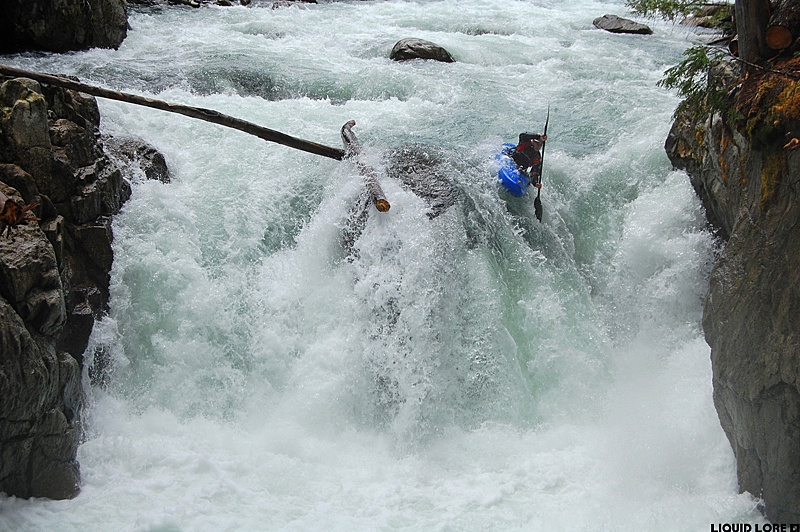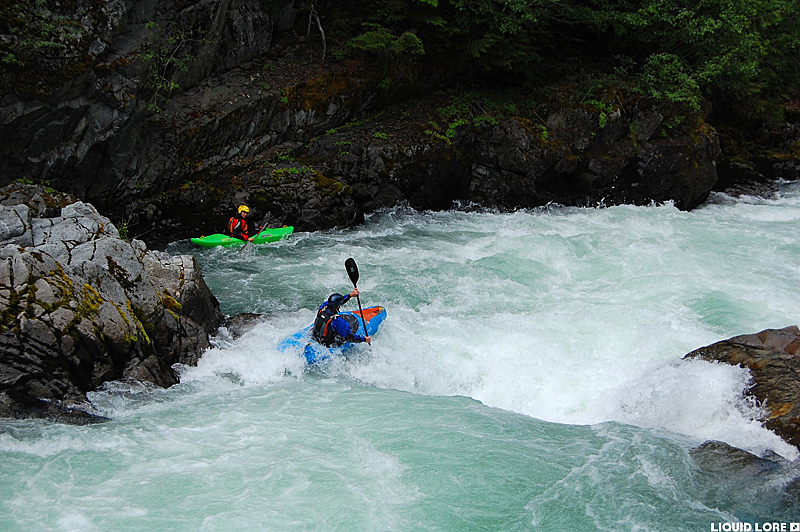Gauge info: if you have previous experience on the Cheak, note that the gauge changed sometime before the 2015 season and now reads about 0.1 m lower than it used to. Levels are adjusted appropriately on this page.
If there ever was a flagship run for the boating around Whistler, the Upper Cheakamus just might be it. Although relatively short it is packed with great rapids from start to finish and it has a season that extends from the start of the melt well into the fall. To top it off there's a small waterfall at the put in that is one of the best boofs in town. No matter if you're a seasoned veteran or someone looking for that next step into continuous and pushy whitewater, you are definitely going to have a good time.
The Upper Cheak is incredibly popular staple run for locals and out-of-towners alike. The take out is at the Function Junction intersection west of Whistler. Turn south, towards Cheakamus Crossing (the athletes village that was built for the 2010 Olympics, now private homes). Take the logging road up the west side of the river. After crossing the bridge there will be a left turn after 100 meters leading to a large parking lot. A trail goes down to the water where you'll find a staff gauge that corresponds to the online gauge.
The put in is further up the west side logging road. Drive up this road for 5-10 minutes. After going up a steep hill that can be rough, the road will flatten out. Shortly you will come to a 3 or 4 car pullout on the left, and you will see the river (shoaly class II-III) through the trees. This is the put in. If you want to run the put in falls go straight to the water here. If you want to start below the falls there is an obvious trail 50 meters back down the road that takes you to the eddy, or the big seal launch, below the falls.
The Cheakamus is runnable at a wide range of flows. A fair minimum is 2.1, where the river is rocky and not pushy. The Cheak starts getting prime at 2.5. At this flow the river is solid class IV the whole way with one rapid that's perhaps a little more challenging. Reasonable upper levels depend on the boater, but it's not unusual to be running it over 3.0 on the gauge (it's class V at high water). As always, difficulty changes accordingly with the level and because of the continuousness you need to act quickly to save gear should someone swim, even at lower flows. There is a good trail along the river left bank the whole way down.
The put in falls is optional. It's a great boof but it does develop a decent hole as the level goes up. Most people who run it regularly start to think twice once the level gets up around 2.9. Below the falls things start right away - the first rapid of note is called Cobra. After this things ease slightly until you see a suspension bridge over head.
There's a good rapid under the bridge which is immediately followed by Triple Drop, the toughest of the run. It has a long entrance with a big hole at the bottom. The river goes on with more of the same below Triple until the take out. The last rapid is called House Rock and it is marked by a big square boulder in the middle of the river. The take out is next to the stick gauge. And that's it - jump out for a second lap or if the level is right keep on going through Balls to the Wall - it's just as good, and a little bit harder.


Upper Cheakamus Trivia
- The put in falls didn't exist until the fall of 2003. A large flood dug a new channel, which dried up a class III rapid and replaced it with the falls.
- A young paddler, Peter Thompson, died while running the put in falls at low water (old 2.3) in 2012. He became trapped on a piece of wood lodged at the bottom of the falls deep in the river left slot. More debris lodged in this slot should always be a consideration at low flow.